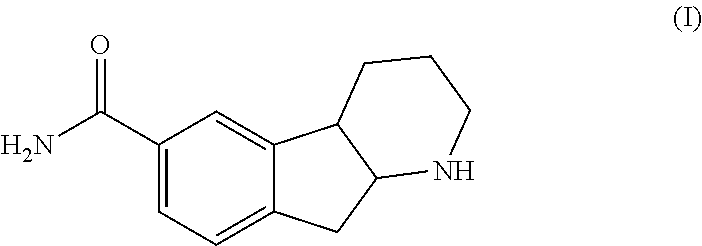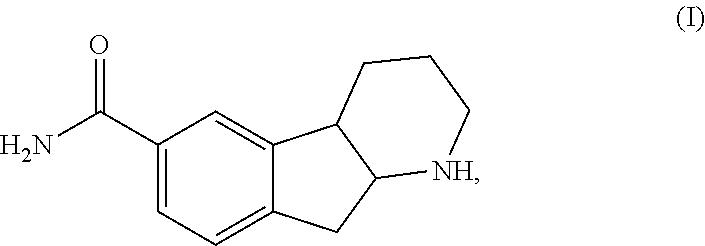Indenopyridine derivatives
a technology of indenopyridine and derivatives, applied in the field of indenopyridine derivatives, can solve problems such as problematic by-product streams
- Summary
- Abstract
- Description
- Claims
- Application Information
AI Technical Summary
Benefits of technology
Problems solved by technology
Method used
Image
Examples
example 1
Preparation of 4aH-indeno[2,1-b]pyridine-1-benzyl-6-carboxamide (II)
[0065]
Step 1. Preparation of 2-(phenylsulfonyl)pyridine
[0066]
[0067]Benzensulfinic sodium salt (21.6 Kg, 131.6 mol) is charged to a reactor and treated with 60 L of a solution of acetic acid and water (3:1 vol:vol). The contents of the reactor are mixed and treated with 2-chloropyridine (30.0 Kg, 264.2 mol). The contents of the reactor are heated to 90° C. and mixed for 2 hrs. An additional solution of benzensulfinic sodium salt (26 Kg, 158.4 mol) in 60 L of acetic acid / water (3:1 vol:vol) is added to the reactor slowly over 5 hours while maintaining the contents of the reactor at 90° C. The contents of the reactor are mixed at 90° C. for about 8 hours, cooled to 20° C., and treated with water (150 L). The contents of the reactor are stirred for 30 minutes and filtered through a centrifuge filter. The filter cake is collected, treated with isopropanol (41.4 Kg, 52.4 L), and stirred at 60° C. After 30 minutes the mixt...
example 2
Preparation of Preparation of 2,3,4,4a,9,9a-hexahydro-1H-indeno[2,1-b]pyridine-6-carboxamide (I)
[0076]
[0077]A reactor is charged with 10% Pd / C (3.52 Kg, 50% wet), Na2CO3 (0.707 Kg), 4aH-indeno[2,1-b]pyridine-1-benzyl-6-carboxamide (8 Kg, 26.7 mol) and MeOH (66 L). The resulting mixture is stirred and inerted 3 times with H2. The reactor is then pressurized with H2 to 200 PSI, the contents heated to 80° C., mixed at 80° C. for 20 hours, and cooled to 20° C. The mixture is then filtered at ambient temperature through a closed filter pre-packed with Celite-545 using N2 pressure. The hydrogenation reactor is rinsed with MeOH (3×18 L), and the MeOH rinses filtered through the Celilte filter. The combined MeOH filtrates contents are then concentrated under reduced pressure to about 10% of the initial volume. The resulting residue is treated with isopropanol (SOL) and concentrated under reduced pressure to about 10 L. The residue is cooled to 25° C., treated with 20 L of MeOH, and heated t...
example 3
Preparation of 2,3,4,4a,9,9a-hexahydro-1H-indeno[2,1-b]pyridine-6-carbonitrile, hydrogen chloride salt
[0080]
[0081]A mixture of 2,3,4,4a,9,9a-hexahydro-1H-indeno[2,1-b]pyridine-6-carboxamide (I), hydrogen chloride salt (7.5 Kg, 25.2 mol) and dioxane (15 L) is stirred for 30 minutes at 25° C. and treated with POCl3 (7.77 Kg, 50.4 mol). The mixture is heated to 80° C. over 1 hour and held at 80° C. for 2 hours. The mixture is cooled to 20-25° C., treated over about 30 minutes with a solution of water (1.376 L, 75.6 mol) in dioxane (30 L), stirred for 30 minutes, and treated with additional water (1.376 L, 75.6 mol). The resulting slurry is stirred at 25° C. for about 18 hours and filtered. The resulting filter cake is washed portion-wise with 3.0 L of 1% H2O in 1,4-dioxane and dried for about 18 hours at ˜50° C. to provide 2,3,4,4a,9,9a-hexahydro-1H-indeno[2,1-b]pyridine-6-carbonitrile (III) in the form of the hydrogen chloride salt. Yield: 4.73 Kg, 20.16 mol; 80%.
PUM
| Property | Measurement | Unit |
|---|---|---|
| temperature | aaaaa | aaaaa |
| temperature | aaaaa | aaaaa |
| temperature | aaaaa | aaaaa |
Abstract
Description
Claims
Application Information
 Login to View More
Login to View More - R&D
- Intellectual Property
- Life Sciences
- Materials
- Tech Scout
- Unparalleled Data Quality
- Higher Quality Content
- 60% Fewer Hallucinations
Browse by: Latest US Patents, China's latest patents, Technical Efficacy Thesaurus, Application Domain, Technology Topic, Popular Technical Reports.
© 2025 PatSnap. All rights reserved.Legal|Privacy policy|Modern Slavery Act Transparency Statement|Sitemap|About US| Contact US: help@patsnap.com



